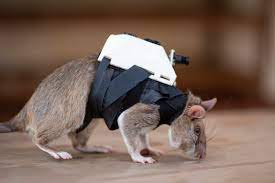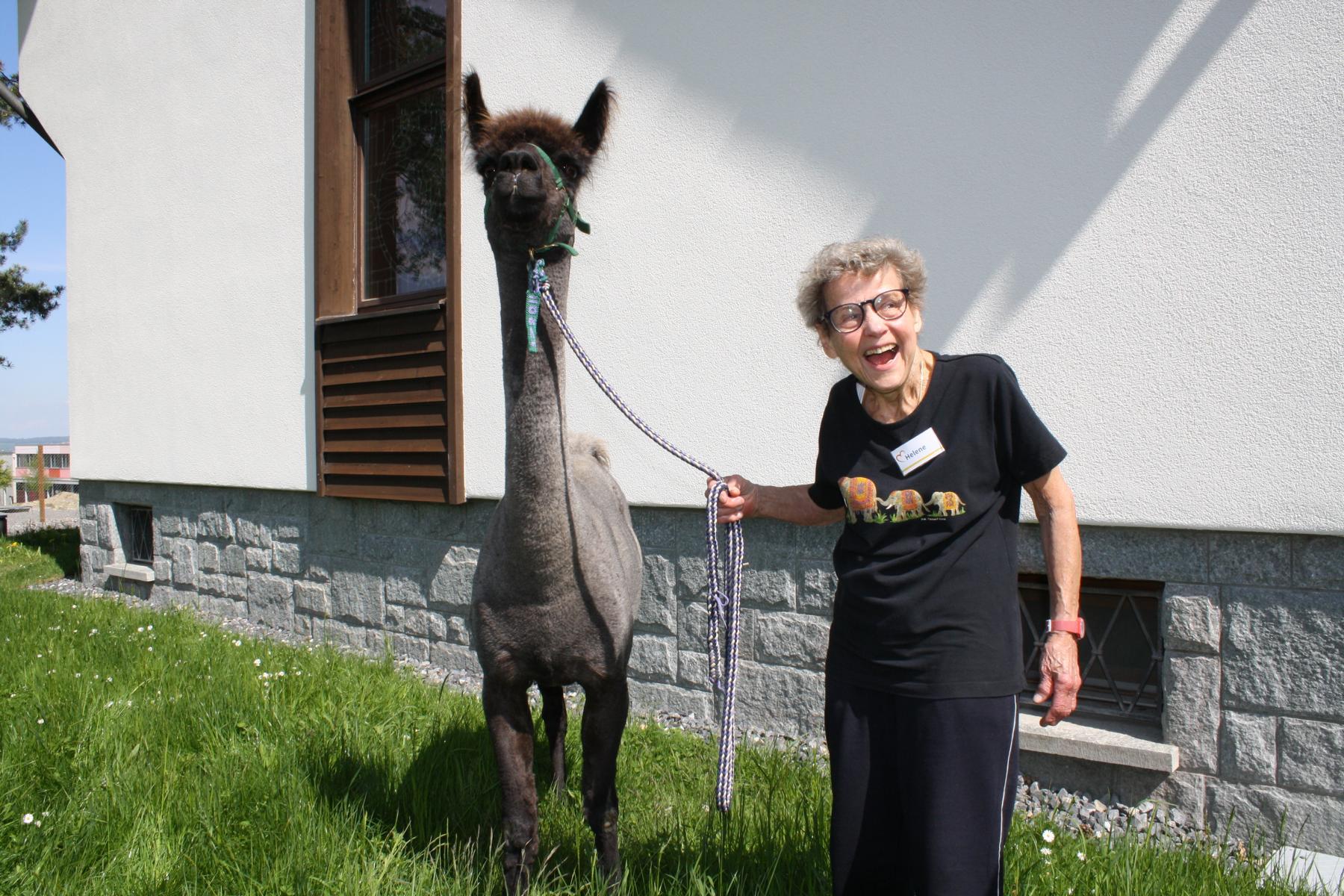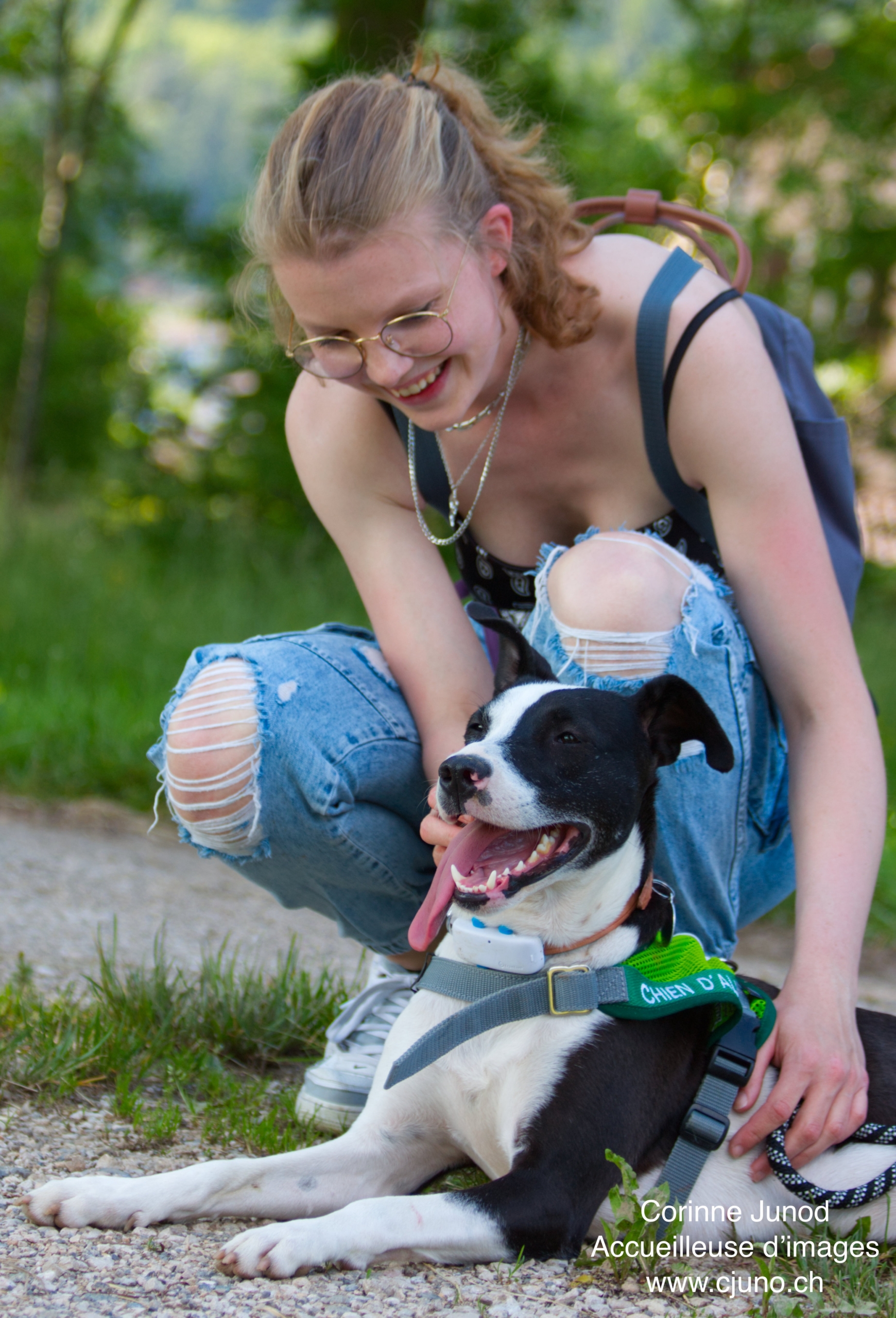We are happy to support projects with the following content
Animal-assisted interventions in general
Animal-assisted interventions is a broad term. It describes the involvement of various species of animals in diverse manners beneficial to humans. This term serves as an umbrella that covers, amongst others, animal-assisted therapy, and animal-assisted education, and animal-assisted activities. The handler partners with an animal, working as a team, to assist other people. AAI fulfills both human and animal needs.
Animal-assisted activities
Animal-assisted activities (AAA) are delivered by specially trained professionals, paraprofessionals, or volunteers in association with specifically trained animals. AAA provide opportunities for motivation, education or recreation with the aim to enhance the quality of life of the participants.
Alert dogs
Alert dogs are specially trained dogs to provide early warning of a potential defined threat, such as a seizure, an absence, a drop in blood glucose or similar health challenges.
The presence of a trained alert dog not only contributes to physical security, but also provides an additional level of emotional well-being for their human companions.
Service dogs
Service dogs are highly specialized animals that support people with different physical, mental or emotional challenges. With intensive training, they acquire skills that are tailored to the individual needs of their owners. Service dogs can perform tasks such as opening doors, picking up objects, recognizing medical emergencies or assisting people with visual impairments. However, their impact goes beyond practical tasks as they also promote emotional support and independence. The close bond between service dogs and their owners makes them indispensable companions that significantly improve quality of life.
Seizure alert dogs
Seizure Alert Dogs play a life-changing role for people with epilepsy. Through special training, these dogs are able to detect seizures in advance and alert their owners. Early detection allows those affected to take protective measures and get to safety. Seizure Alert Dogs provide not only physical support, but also emotional security and independence for their owners by helping to cope with everyday life despite the challenges of epilepsy. Their exceptional instincts and unconditional devotion make them reliable partners for people living with epileptic seizures.
Hearing dogs
Hearing dogs, also known as hearing service dogs, are trained to assist people with hearing impairments. These sensitive dogs can recognize important sounds such as doorbells, telephone rings or alarm signals and alert their owners to them. Through their specialized training, Hearing Dogs provide more independence and safety in daily life for people with hearing loss. The close bond between these dogs and their owners not only provides practical help, but also strengthens emotional well-being by offering reliable, loyal companionship. Hearing dogs therefore play an important role in promoting quality of life for people with hearing impairments.
Allergy alert dogs
Allergy alert dogs, specialize in helping people with severe allergies. These dogs are trained to recognize certain allergic reactions, for example to food or environmental allergens, and warn their owners. Thanks to their keen sense of smell, Allergy Alert Dogs can alert people to potentially dangerous substances at an early stage, enabling them to take protective measures in good time. The presence of these specially trained dogs not only provides physical safety, but also helps to make daily life easier for people with allergies by increasing their sensitivity to potential dangers.
Dementia support animals
Dementia Support Animals play an important role in supporting people with dementia. Specially trained animals, often dogs or cats, provide emotional support, structure and companionship for people with dementia. Through their calming presence, these animals can reduce anxiety and have a positive effect on the emotional well-being of those affected. Dementia Support Animals can help to encourage social interaction, create memories and provide an improved quality of life for people with dementia. Their empathetic nature and potential to create connections make them valuable companions in care facilities and for family caregivers.
Animals supporting people and nature
Animals supporting people and nature form a symbiotic relationship that contributes to the well-being of both. In various contexts, animals play pivotal roles in fostering connections between individuals and the natural world. Whether through therapy animals providing emotional support to people, service animals aiding individuals with disabilities, or conservation efforts involving animals protecting ecosystems, the impact is profound. Animals contribute to human health, happiness, and rehabilitation, while also serving as stewards of biodiversity and environmental balance. This interconnectedness highlights the importance of recognizing and nurturing the mutually beneficial relationship between animals, people, and the broader natural world for a harmonious coexistence
Facility animal
Facility Animals, also known as visiting or facility animals, are specially trained animals that are accompanied by a dog owner and handler. These teams visit community facilities such as hospitals, retirement homes or schools to promote positive social interactions and enhance the well-being of people. The dog owner is often the animal's trainer and works closely with the handler to ensure the animal responds appropriately to different situations. Facility Animals help to create a supportive and positive atmosphere by providing joy, comfort and therapeutic benefits for people at different stages of their lives.
Resident animal
Resident Animals living in facilities for the elderly or other groups play a special role in creating a warm and supportive environment. These animals, dogs, cats, goats, ducks, birds, are permanent residents of the facility and provide companionship and emotional support to people. The presence of resident animals encourages social interaction and creates a family atmosphere in the residential community. The animals are often cared for by qualified caregivers to ensure that their needs are met. Resident animals therefore make a significant contribution to improving the quality of life in care facilities.
Guide dogs for the visually impaired
Guide Dogs for visually impaired individuals are extraordinary companions trained to enhance independence and mobility. These highly skilled dogs assist their owners in navigating through various environments, avoiding obstacles, and safely crossing streets. Through rigorous training, these guide dogs develop a deep bond with their visually impaired partners, creating a relationship built on trust and mutual reliance. Beyond their practical assistance, these dogs provide emotional support, boosting the confidence and overall well-being of individuals with visual impairments. The partnership between guide dogs and their owners exemplifies the transformative impact of the human-animal bond, enabling greater autonomy and a richer quality of life for those facing visual challenges.
Bark beetle-sniffing dog
The bark beetle sniffer dog is an innovative addition to the fight against the threat of bark beetles in forests. Through special training, dogs are conditioned to recognize the characteristic smell of bark beetles and their feeding galleries in trees. With their exceptional odor sensitivity, these dogs enable the early identification of infestations, which enables precise and efficient control of the pests. The use of bark beetle sniffer dogs not only helps to maintain healthy forest stands, but also supports the ecological balance and protects the forestry industry from significant economic losses. This targeted use of the olfactory abilities of dogs demonstrates the versatility of animal assistance projects in the field of environmental protection and sustainable resource conservation.
Anti poaching animals
Anti-poaching animals play a crucial role in the protection of endangered species and the conservation of ecosystems. Specially trained animals, such as dogs, are used to assist wildlife rangers in tracking down poachers. Their exceptional skills allow illegal activities to be detected before they have serious consequences for wildlife. These anti-poaching animals are indispensable partners in anti-poaching efforts, helping to protect endangered species and conserve biodiversity. Their role underlines the need for a holistic strategy in the fight against poaching and illegal wildlife trade.
Tuberculosis Detection Rats
Tuberculosis Detection Rats play an innovative role in the early detection of tuberculosis (TB). These specially trained rats have an amazing ability to detect TB pathogens in sputum samples. Their high accuracy enables faster and more cost-effective diagnosis compared to conventional methods. The Tuberculosis Detection Rats help to improve access to TB diagnosis in regions with limited resources and enable earlier initiation of the necessary medical measures. Their use demonstrates the potential of animals in medical diagnosis and helps to strengthen the fight against infectious diseases worldwide.
Landmine detection animals
Landmine detection animals represent a remarkable progress to address the issue of landmines. These specially trained animals, often dogs or rats, exhibit an extraordinary ability to detect the scent of explosives, aiding in the identification and removal of landmines from affected areas. Their precision and efficiency make them invaluable assets in post-conflict zones, contributing to the safety and well-being of communities. Ongoing research in this field focuses on refining training techniques and expanding the use of detection animals to accelerate demining processes. By harnessing the innate skills of these animals, landmine detection initiatives underscore the impactful role animals play in promoting human security and environmental recovery.
Animals protect animals and nature
The concept of animals protecting animals and nature showcases the intricate web of relationships that exist within ecosystems. Predatory species often play a crucial role in controlling populations of certain prey, preventing overgrazing or imbalance in the food chain. Additionally, symbiotic relationships, such as the oxpecker birds and large mammals, demonstrate how animals collaborate for mutual benefit – the birds remove parasites from the mammals, while the mammals provide a source of food and protection. In marine environments, certain fish species protect coral reefs by consuming algae that could otherwise harm the delicate ecosystem. These interdependent relationships underscore the importance of biodiversity and the delicate balance maintained by animals in safeguarding the health and sustainability of our natural world.
Research
Research in the field of animal assistance has been instrumental in uncovering the vast potential of animals to positively impact human lives and the environment. Studies on Seizure Alert Dogs, Emotional Support Animals, and Allergy Alert Dogs, among others, have provided valuable insights into the effectiveness of these interventions. The findings not only validate the practical benefits these animals bring to individuals with specific needs but also contribute to refining training methods and expanding the scope of animal assistance projects. Ongoing research is crucial for continuously improving the understanding of the complex relationships between animals, humans, and nature, fostering advancements that can further enhance the efficacy and inclusivity of animal support initiatives.





